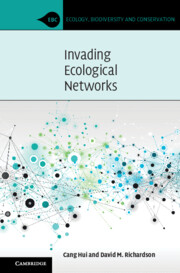Book contents
- Invading Ecological Networks
- Ecology, Biodiversity and Conservation
- Invading Ecological Networks
- Copyright page
- Epigraph
- Contents
- Preface
- Acknowledgements
- 1 Invasion Science 1.0
- 2 Relentless Evolution
- 3 Network Assembly
- 4 Regimes and Panarchy
- 5 Network Transitions
- 6 Network Scaling
- 7 Rethinking Invasibility
- Glossary
- Index
- Plate Section (PDF Only)
- References
6 - Network Scaling
Published online by Cambridge University Press: 05 May 2022
- Invading Ecological Networks
- Ecology, Biodiversity and Conservation
- Invading Ecological Networks
- Copyright page
- Epigraph
- Contents
- Preface
- Acknowledgements
- 1 Invasion Science 1.0
- 2 Relentless Evolution
- 3 Network Assembly
- 4 Regimes and Panarchy
- 5 Network Transitions
- 6 Network Scaling
- 7 Rethinking Invasibility
- Glossary
- Index
- Plate Section (PDF Only)
- References
Summary
Maps of global biomes or ecoregions show geographical clusters – unique assemblages of plants and animals that are spatially tied with associated geomorphologic and climatic features. Biomes are typically defined on the basis of broad vegetation types and the biophysical features that impose fundamental controls on the distribution of plants (Cox and Moore 2000). The concept of biomes has a deep history in ecology and has experienced waves of knowledge synthesis, reaching a recent consensus of seven points (Mucina 2019), one of which caught our attention: ‘A biome incorporates a complex of fine-scale biotic communities; it has its characteristic flora and fauna and it is home to characteristic vegetation types and animal communities.’ Macro-scale biodiversity patterns, therefore, reflect the overarching geophysical structures of the globe such as the well-known latitudinal gradients of biodiversity (Willig et al. 2003) and associated ecosystem functioning (e.g., litter decomposition in streams via detritivores; Boyero et al. 2015). Nevertheless, within constantly changing environments, the species composition and geographical boundaries of biomes (called ecotones) are not fixed, but are fluid over evolutionary timescales (Haywood et al. 2019). This biodiversity–environment coupling has been disrupted by agriculture and urbanisation, and the appetite of humans for resources and raw materials and their carelessness in handling waste. Humans are steadily altering land cover and modifying ecological processes across the globe, creating a new ecological order of anthropogenic biomes (anthromes; sensu Ellis and Ramankutty 2008). Natural biomes are facing unprecedented pressures to change, shift, dissolve, merge and emerge, at a pace on par with the most tumultuous periods of the biosphere’s history.
- Type
- Chapter
- Information
- Invading Ecological Networks , pp. 318 - 369Publisher: Cambridge University PressPrint publication year: 2022

